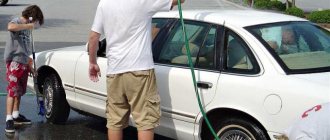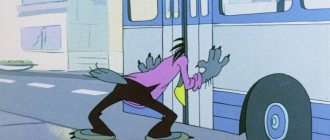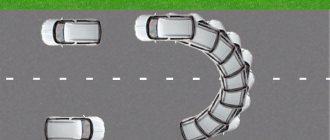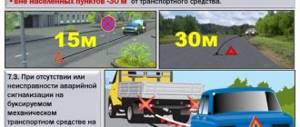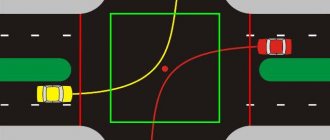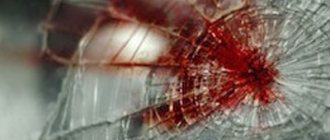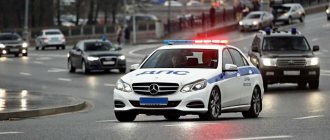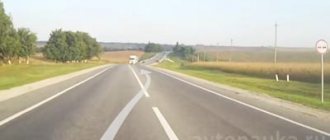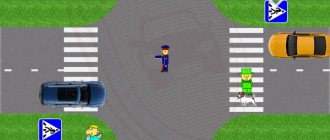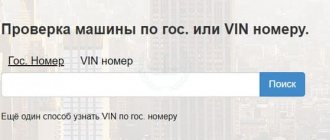When should this be done?
An emergency stop sign, which is a red equilateral triangle, is placed on the road so that other road users have time to take measures to safely bypass the emergency vehicle.
This sign must be displayed when the vehicle stops and the hazard warning lights are turned on in the following cases:
- in case of a traffic accident;
- when forced to stop in places where it is prohibited;
Question answerHow long can you stand at the emergency lights in the area of the “No Stopping” sign?
- when forced to stop in places where (taking into account visibility conditions) the vehicle cannot be noticed in a timely manner by other drivers.
A warning triangle is installed at a distance of at least 15 meters from the vehicle in populated areas and 30 meters outside populated areas.
This is interesting: The end of the world: why did drivers start driving without low beams?
What to do if you have to stop
If the driver makes a forced stop, the following actions must be taken:
- turn on the alarm (clause 7.1.);
- put up an emergency stop sign as soon as possible to alert road users to the danger; in a populated area - at a distance of at least 15 and outside the city - at least 30 meters from the car (clause 7.2.);
- When making an emergency stop in places where this is prohibited, the driver must drive the vehicle away from the stopping place (clause 12.6.).
All these actions must be performed immediately only if signs prohibiting stopping are installed. If the driver parks in a place where a stop is provided, then all of the above is not necessary.
At the railway crossing
According to clause 15.5, the driver must remove passengers from the passenger compartment and do everything possible to remove the vehicle from the tracks. In other cases, you need to do the following:
- if possible, send two people along the tracks in the opposite direction from the car to give a warning signal to the driver of the approaching locomotive for emergency braking;
- stay close to the car and sound alarms consisting of one long and three short beeps;
- if a train appears, move towards it, holding a red rag or torch in your hands.
A railway crossing is a place of increased danger, so when passing through it, you must take all precautions.
On the motorway
Based on clause 16.2. in the event of an emergency stop of movement on the roadway, the driver must mark the car in accordance with safety requirements and try to place it behind the strip marking the edge of the roadway.
It is prohibited to stop on the motorway, but if there is a need for an emergency stop, you need to park the car outside the traffic lane, that is, on the side of the road. In this case, there is no need to independently transport the car to the nearest parking lot, which may be far from the current location.
What's really happening?
It is not uncommon for drivers to view such an alarm as an indulgence from a violation. It seems to them that if you turn on the emergency lights, then even a serious violation of the rules will not be punishable by any fine. However, in reality, any traffic police inspector will confirm to you that a violation will always remain a violation, regardless of whether the driver turned on the emergency lights or not.
Don’t be fooled by the fact that many car owners, when reversing incorrectly, creating obstacles in the parking lot and violating traffic rules, turn on the hazard lights, thereby hoping to warn other road users, which, in their opinion, should help them avoid an accident, as well as penalties from the traffic police. In reality, such an activated emergency light does not in any way reduce the driver’s responsibility for violations on the road.
Also, such alarms are often used by car hooligans who rarely follow traffic rules. It seems to them that cars with emergency lights on should let them pass everywhere, and they can cut off other cars on the road, which invariably provokes accidents. In practice, such behavior of other drivers only irritates car owners who always follow the rules of the road.
When can you legally turn on your emergency lights?
To put it simply, you can turn on the hazard warning lights when something goes wrong. For example, a justified situation would be to turn on the emergency lights even when parking in a prohibited place, if this is caused by a car breakdown . Such a place could be the side of a highway, where, according to traffic regulations, stopping and parking is prohibited. Also, the emergency lights can be turned on anywhere in the event of an accident.
Emergency lighting should also be turned on when the vehicle is stationary in poor visibility conditions. A complete list of situations when the emergency lights can be activated is contained in paragraph 7.1 of Chapter 7 of the Road Traffic Rules approved by the Government of the Russian Federation.
Here's when the hazard lights should be on:
- in case of an accident
- when forced to stop in places where stopping is prohibited
- when the driver is blinded by headlights
- when towing (on a towed motor vehicle)
- when boarding children in a vehicle with identification marks “Transportation of Children” and disembarking from it
- in other cases when it is necessary to warn road users about the danger that a vehicle may create
What are other cases? According to the comments to this legal norm, the last item on the list of legality of turning on the emergency lights is not precisely regulated. That is, when to turn on the hazard lights, the driver decides at his own discretion.
So, the law allows you to use your hazard lights if you want to warn other drivers about a dangerous event on the road , for example you can tell other drivers about an accident or a slippery road. It is also allowed to turn on the emergency lights during sudden sudden braking. By the way, today there are many modern cars where the emergency lights turn on automatically when braking sharply. Including if your car is broken down and you cannot drive quickly, you also have the right to turn on your hazard lights while driving at low speed.
How does the alarm circuit work?
Due to the large number of connecting wires, the modern alarm circuit has become significantly more complicated compared to its prototype, and consists of the following: the entire system is powered only from the battery, so it can ensure its full operation even if the ignition is turned off , i.e. while the vehicle is parked. At this time, all the necessary lamps are connected through the contacts of the alarm switch.
When the alarm is on, the power circuit operates as follows: voltage is supplied from the battery to the contacts of the mounting block, then it is supplied directly to the alarm switch through a fuse. The latter connects to the block when the button is pressed. Then it, again passing through the mounting block, goes to the turn signal relay.
The load circuit has the following diagram: the alarm relay is connected to contacts, which, when the button is pressed, come into a closed position with each other, thus they connect absolutely all the necessary lamps. At this time, the warning lamp is switched on in parallel through the contacts of the hazard warning switch. The connection diagram for the alarm button is quite simple, and it will take you no more than half an hour to master. It is necessary to remember its importance, so be sure to monitor its condition.
Simulated emergency stop
Some motorists believe that the emergency alarm can cancel the effect of sign 3.27 “Stopping is prohibited” and, abusing the permission of Article 7 of the Traffic Regulations of the Russian Federation, they stop driving in any prohibited places. Cars stand for half an hour on the edge of the roadway with flashing yellow lights, while the car owner walks around the nearest store or “for a minute” visits a friend in the nearest office. Such stops cannot be considered forced, and they are not an excuse for violators. In these cases, traffic police officers draw up a protocol to the fullest extent. The use of an alarm system to simulate a breakdown within the coverage area of sign 3.27 is prohibited by the Code of Administrative Offences.
In accordance with Article 12.19 of the Code of Administrative Offenses of the Russian Federation, violation of the rules for stopping or parking vehicles entails a warning or the imposition of an administrative fine in the amount of five hundred rubles. A violation committed in a city of federal significance (Moscow or St. Petersburg) entails an administrative fine in the amount of two thousand five hundred rubles.
TsODD and traffic police specialists act even more radically when considering administrative protocols compiled by photo-video recording systems. A car parked at the emergency stop is a priori considered to have violated the rules, and the driver has to prove his innocence if the vehicle was indeed faulty and required repairs. You can confirm a breakdown on the highway with a certificate from a technical service, whose technicians, for example, came to the rescue and repaired the car at the edge of the road.
Traffic regulations instructions
The current traffic rules today clearly stipulate in what cases hazard warning lights can and should be used. So, according to paragraph 7 of the rules, it must be turned on in case of traffic accidents, blinding of the driver, or a forced stop in the wrong place. Also, vehicles that are designed specifically for transporting children can use such an alarm when they drop off passengers.
In case of a traffic accident, in accordance with the rules, it is necessary not only to turn on such an alarm, but also to install an emergency stop sign. If both of these requirements are not met, the traffic police inspector has the right to consider this as a violation of the rules for operating the vehicle, and accordingly, a fine may be imposed on the driver.
Often car owners, when tuning their car, change the lighting equipment, after which the hazard warning lights flash red or white. It should be said that this is prohibited by traffic regulations, so such a car will have certain difficulties when passing inspection. Any traffic cop can check the operation of the emergency lights and will have the right to impose a fine on the driver in the amount of 1000 rubles. In case of repeated violation, the fine increases to 5,000 rubles. Operation of such vehicles on public roads is not permitted.
Many drivers mistakenly believe that, according to current traffic rules, it is mandatory to turn on the emergency lights on a car when it is towed on a cable. However, there are no mandatory requirements in the traffic rules. On the contrary, when the emergency lights are turned on, it is difficult for other road users to determine whether such a towed car will turn or go straight. Accordingly, an emergency situation may arise, and the culprit of the accident will be the driver who incorrectly uses the hazard warning lights.
There is also no need to turn on the hazard warning lights when reversing. Some foreign cars have automatic systems configured in such a way that as soon as we engage reverse gear, the emergency lights are activated. However, there are no special requirements for this, so if possible, this option should be deactivated so that the car fully complies with the requirements of road traffic regulations.
Experienced drivers recommend that beginners use emergency lights correctly, which will make driving somewhat easier, increasing overall safety while driving. For example, at night, if you are stuck on the side of the road or stuck in a traffic jam on the unlit side, it would be a good idea to turn on the hazard lights to warn other drivers about the presence of an obstacle on the road.
At night, it is recommended to turn on the emergency lights whenever you stop on the side of the road. Even if the road is well lit, such a car with its hazard lights on will be clearly visible from a distance, which will improve safety on the road.
You can also use this emergency light to thank other drivers on the road. For example, if you were let through and allowed to change lanes into a busy lane, you can turn on the emergency lights for a few seconds to thank another polite driver.
Hazard alarms are used when the car is damaged in an accident, or if it is necessary to stop at a place where the car poses a danger to other vehicles. If you can move at a low speed, you can move into the right lane and continue driving with the hazard lights on.
Moreover, there is an exception to the last rule. If the car cannot accelerate to 40 km/h ,
then
on the highway
. In this case, they pull over to the side of the road and stop (by putting up a stop sign and also turning on the hazard lights).
Actually, the cases in which the emergency alarm really needs to be turned on were listed above. We’ll also add here towing and getting children in and out (when the vehicle is equipped with a “Children” sign). And in any other situation (for example, when stopping at an intersection), turning on the hazard warning lights is extremely undesirable. This will distract other road users from the road.
The following misconception is common. It seems that on some foreign cars the hazard lights turn on automatically, and when braking
(but, unlike “stops”, not when the pedal is accidentally pressed). Let us explain what exactly is actually happening.
“Hazard light” - does not duplicate the brake light
There is the following option option. When the car performs emergency braking and slows down, the hazard warning lights come on. But they blink at twice
than in emergency mode (such a signal cannot be confused with an “emergency” signal).
This option is supplied to luxury versions of passenger cars, and it has become widespread in some countries of northern Europe. The Russian Rules, however, do not consider anything like this. If the signal from the deceleration sensor can be used, then it makes sense to connect it to an additional brake light (and not to the emergency lights).
A common mistake is the following behavior on the road. After stopping, the driver installs a special sign, as prescribed in the traffic rules. But the hazard lights remain off. What violates Art. 12 clause 20 of the Administrative Code.
Road safety is an urgent need for every (even the most reckless) driver. This is especially true for non-standard situations. For example, a car engine is running, but has lost a lot of power.
The forced stop and quick repairs did not give positive results: you can move, but at low speed. In such a combination of circumstances, a line of vehicles will gather on the narrow road behind, the drivers of which will openly or covertly express their dislike by such snail-like driving.
You could even die from hiccups! But for such unusual cases, an emergency alarm was invented.
Every modern car has a button to turn on the hazard warning lights. It can take on the most intricate shapes: round, square, rectangular, etc. But two circumstances unite all options for emergency buttons:
- it is located within reach of the driver;
- it depicts a triangle, symbolizing an emergency or dangerous situation.
After pressing such a button, releasing it or touching it in sensor mode (it all depends on the design of the car), all six turn signals (in common parlance - turn signals) will begin to blink in the same mode with the same frequency.
At the same time, two arrows will light up on the instrument panel, signaling the operation of the turn signals, and an unpleasant monotonous clicking sound will be heard from under the panel (this is the hazard warning relay working).
Light signals flashing along the perimeter of the car body are clearly visible to other road users. This is a warning to other drivers about the danger.
Driver actions during a forced stop
7.1. The hazard warning lights must be turned on:
- when forced to stop in places where stopping is prohibited;
7.2. When a vehicle stops and the hazard warning lights come on, as well as when they are malfunctioning or missing, an emergency stop sign must be immediately displayed:
- when forced to stop in places where it is prohibited, and where, taking into account visibility conditions, the vehicle cannot be noticed in a timely manner by other drivers.
12.6. If forced to stop in places where stopping is prohibited, the driver must take all possible measures to remove the vehicle from these places.
So, when a vehicle is forced to stop, the driver must:
- Turn on the hazard warning lights.
- Set up a warning triangle (red-orange triangle).
- Take measures to remove the vehicle. That is, you need to push or tow the car to where stopping is allowed.
In this case, all of the above must be done only if stopping in a given place is prohibited :
If stopping is permitted, the driver should not do anything additional. You just need to start eliminating the reason that caused the cessation of movement.
At the railway crossing
15.5. When forced to stop at a crossing, the driver must immediately unload people and take measures to clear the crossing. At the same time, the driver must:
- if possible, send two people along the tracks in both directions from the crossing 1000 m (if one, then in the direction of the worst visibility of the track), explaining to them the rules for giving a stop signal to the driver of an approaching train;
- stay near the vehicle and give general alarm signals;
- When a train appears, run towards it, giving a stop signal.
Note. The stop signal is a circular movement of the hand (in the daytime with a piece of bright material or some clearly visible object, at night - with a torch or lantern). The general alarm is signaled by a series of one long and three short beeps.
If you stop at a railway crossing, the first thing you need to do is ensure the safety of people, i.e. remove everyone from the vehicle. After this, you need to try to push the car or stop the train.
Please note that stopping at a crossing is extremely dangerous in any case, so it should be avoided. To do this, it is better to cross railway tracks at such a speed that even if the car unexpectedly breaks down, it will coast out of the crossing.
On the motorway
16.2. When forced to stop on the roadway, the driver must designate the vehicle in accordance with the requirements of Section 7 of the Rules and take measures to move it onto the designated lane (to the right of the line marking the edge of the roadway).
Unlike other roads, when forced to stop on a highway, the car must be taken off the roadway (to the side of the road). Let me remind you that you are not allowed to stop on the sides of highways. However, an exception has been made for forced stops.
Those. on the highway, there is no need to comply with the requirements of paragraph 12.6 and try to push the car to the nearest designated parking lot, which may be located several tens of kilometers from the place where the malfunction occurred. You just need to place the car on the side of the road.
Installation and configuration instructions
Installing emergency lights on a VAZ 2101 is not a particularly difficult task; almost anyone can cope with it. To properly connect the emergency lights to a VAZ 2101 with your own hands, you need to prepare everything you may need to complete the task.
Set of tools and materials
So, what you need to prepare before starting the process:
- Locksmith tools, including wrenches, screwdrivers, pliers, etc.
- Insulating tape.
- Four-contact light signal relay from the “Six”.
- Six-pin button for activation.
- Five meters of installation wire (video by Alex Gordon).
Work execution algorithm
So, let's start the process:
- First you need to remove the center console. To do this, you need to unscrew the bolts that secure the trim to the steering column. You will also need to remove the side trims of the windshield pillars.
- Having done this, you can remove the instrument cluster. Be careful not to damage the device.
- Next, disconnect the wires from the light bulb that illuminates the glove compartment. Then unscrew the bolts that secure the sides of the glove compartment to the control panel, as well as the bolts that secure its lower part. After unscrewing all the screws, the glove compartment itself can be removed.
- Now you need to remove the screws that secure the bottom of the dash to the front cross member. Then the nuts of the upper fastening are unscrewed; it is best to reach them through the technological opening of the glove compartment.
- After completing these steps, you can remove the handles from the stove control panel. To do this, at the junction of the lever with the handle, use a screwdriver to bend the lower part of the upper handle, and at the lower handle, you need to bend the upper part.
- Next, you need to disconnect the connectors with wires from the control panel backlight switches, side lights, and also the stove. Then, using a wrench, you need to unscrew two more bolts that secure the fastenings of the stove control levers. After completing these steps, you will be able to dismantle the control panel.
- Now let's move on to installing and connecting the main elements. First, decide on the location of installation of the system power button. It should be installed on the center console so that the driver can reach it as quickly as possible if necessary. It’s still too early to install the button, but you need to decide on the installation location now, since this will determine how much wire you need. Now remove the old turn signal relay from the car and disconnect the three cables from it - usually they are colored black, gray-white and orange.
- Next, take a new six-wheel relay. The second contact of the relay must be connected to the wire that was removed from contact L on the turn signal relay, as well as to output 7 of the button.
- The first contact of the relay must be connected to the fourth contact on the button itself. The third contact is connected to the cable disconnected from contact P on the turn signal relay. Then you need to connect the cable from the fourth contact to ground, that is, the body of the vehicle - it is best to connect it to the relay fixing nut.
- The next step is to connect the button itself. The fourth contact of the button should be connected to the first contact of the relay used. Its second contact must be connected to the cable that was disconnected from the positive contact of the rotary relay. The seventh contact is connected to the second contact of the relay, and the first and third contacts are connected to the steering column turn signal switch; in this case, the order of connection does not matter.
- Now all you have to do is connect the eighth pin to any positive cable; alternatively, you can wedge it into the electrical circuit from the cigarette lighter. If you decide to connect the plus directly to the battery or generator unit, the circuit will need to be protected with a fuse.
- At this point, the installation procedure can be considered complete. All you have to do is securely fix the wiring to prevent chafing of the cables. Reinstall all previously removed interior trim elements, center console, glove compartment, etc.
Every car owner tries to protect his vehicle from theft as reliably as possible. One solution in this case is to install a car alarm. Most car enthusiasts prefer to pay money to the installer to be sure of the quality of the system installation, but sometimes people install alarms on their cars themselves. What is the connection diagram and how to install it yourself - read below.
This is interesting: Violation of the rules for transporting people or how much does security cost?
What is a forced stop? Definition
Terms and wording are given in paragraph 1.2 of the Russian Traffic Regulations:
A forced stop is a cessation of movement of a vehicle (vehicle) caused by its technical malfunction, the state of health of the driver or passenger(s), an unexpected obstacle that does not allow further movement, as well as the danger posed by the cargo being transported.
At the same time, in order for a stop to be considered forced, it is enough to fulfill one of the described conditions. We will return to them in more detail, but first we will look at cases that will definitely not be considered a forced stop.
What is not a forced stop?
For all further proceedings, it is fundamental to distinguish the term “forced stop” from cases when the cessation of movement is not such.
Firstly, the traffic rules establish the concept of a stop as an intentional suspension of the movement of a vehicle, limited in time (up to 5 minutes), or a period for performing necessary actions - in particular, loading and unloading or boarding and disembarking passengers.
That is, the concepts of simply “stopping”, as an intentional phenomenon, and “forced stopping,” as an event, unpremeditated, in a certain sense unpreventable, are clearly distinguished. what happened to avoid worse consequences.
Secondly, there are rules that require stopping a vehicle in certain circumstances (including forced, emergency). Vivid examples are to allow vehicles with a special signal to pass, to avoid an accident, or to fulfill the requirements of a traffic police inspector (GAI). Such a cessation of movement will also not be forced.
8(800)350-23-68
Dmitry Konstantinovich
Expert of the site "Legal Consultant"
Ask a Question
The second case includes all, relatively speaking, technical stops. For example, traffic lights, crossings and, importantly, traffic jams. Unfortunately, there is no such concept as a “traffic jam” in the Rules (except for the norms for crossing an intersection that are relatively suitable for this definition), but according to established practice, a temporary traffic jam is not perceived by traffic police officers and/or cameras as a violation of the requirement to prohibit stopping. At the same time, a traffic jam does not apply to cases of forced stopping, because does not have any of its characteristics.
The third point that needs to be paid attention to is the effect of all rules related to a forced stop only in cases where a regular stop is prohibited (by signs, markings, etc.). If there is no prohibition, any stop is carried out according to normal standards.
In what case will the driver make a forced stop?
Stopping just before a crosswalk to give way to the pedestrian.
2.63%
Stopped on the roadway due to a technical malfunction of the vehicle.
78.95%
In both of the above cases.
18.42%
Voted: 38
Correct answer
Stopped on the roadway due to a technical malfunction of the vehicle.
When are you required by law to turn on your hazard lights?
Any driver must press the vehicle's hazard warning light button and activate ACC in several cases:
- If the driver had to stop right in the middle of the road while driving. The need to stop may be due to a breakdown of the vehicle or poor health of the driver. In this case, it is necessary to activate the hazard warning switch until the car comes to a complete stop, otherwise an accident may occur.
- When a car is stopped by a traffic police officer or the driver is blinded by an oncoming vehicle.
- When a driver operates a vehicle with defects that could lead to an accident. Please note that in this case, operation of the vehicle is permitted unless prohibited by current traffic regulations.
- If the vehicle is being towed by another vehicle, the hazard lights should always be switched on, as this will alert other road users.
- In the event that you are transporting children in a car, the corresponding sign is installed on the car, and you are disembarking or picking them up.
- When cars are moving in a convoy, but one of the vehicles is forced to stop. Moreover, if the hazard warning lights are turned on on one car, other drivers are also required to turn them on.
- Naturally, the emergency lights must be turned on if the car is involved in an accident.
All these situations are regulated by traffic rules. But there are other cases when activating ACC alone is not enough and the motorist needs to place an appropriate warning triangle on the road. If this sign is not there, it can be replaced with a red light, and this light source should blink similar to an emergency light. The installation of this sign or lantern is placed at a distance of no more than 20 m from the vehicle if the stop was made in a populated area.
If the problem has overtaken you outside the city, then the sign should be installed at a distance of no closer than 40 meters, and this can be done in the following cases:
- If the car is involved in an accident. If this happens, then you need to take into account that the machine can not only be a hindrance to other machines, but also affect their safety. Accordingly, the further away you place the sign, the more time the driver of the other car will have to assess the situation on the road and perform the correct maneuver.
- Another case is if you had to stop where visibility is poor or limited. In such situations, the sign must be placed no closer than one hundred meters from the vehicle, both in front and behind.
Hazard warning and warning triangle
If you make a forced stop in the middle of the roadway, you need to draw the attention of other road users to your vehicle. To do this, turn on the hazard warning lights and put up a warning triangle. The same is done in situations where the vehicle is parked near the sidewalk or on the side of the road, in a place where stopping is prohibited or where the car is difficult to see from afar. Thanks to the measures taken, other drivers will see the obstacle in their path in advance, will be able to orient themselves in time and avoid hitting it.
The hazard warning light button is usually located in the center of the dashboard. It is easily recognized by the white or red triangle depicted. A warning triangle must be located in the trunk or interior of every vehicle. It is stored folded. The sign consists of a stand and three bars, hingedly connected to each other. The strips are made of reflective material, making the sign clearly visible on the road both day and night.
Clause 7.1. Traffic regulations oblige drivers to turn on the hazard warning lights in the following situations:
- road accident;
- towing a vehicle;
- forced stop in prohibited places;
- driver blinding by headlights;
- boarding and disembarking children in vehicles during their organized transportation.
To warn road users of danger, you should also turn on the hazard warning lights on both a moving and a stationary vehicle. However, having the emergency lights on is not an excuse for violating traffic rules and does not relieve the driver of responsibility.
In the event that the hazard warning lights are on and cannot warn other drivers about the danger in time, it is necessary to display an emergency stop sign. The sign should be placed in such a place that it can be seen from afar.
In clause 7.2. The traffic rules contain a list of situations in which a warning triangle must be displayed. In other cases, the driver himself determines the need to install it. The clause also normalizes the minimum permissible distance at which the sign must be placed. Thus, in populated areas the distance from the vehicle to the sign must be at least 15 meters, outside the city - at least 30 meters.
Clause 7.3. The rules describe another case of using a warning triangle: when towing a vehicle with a faulty battery and a non-functioning hazard warning light. In such a situation, it must be installed on the rear of the towed vehicle.
Article 12.20. The Code of Administrative Offenses of the Russian Federation provides for liability for violation of the requirements of Chapter 7 of the Rules in the form of a warning or a fine of 500 rubles. But according to Article 12.27.1. If the emergency lights are not turned on and the emergency sign is not displayed in case of an accident, they will entail a fine of 1,000 rubles.
Outside the populated area
Outside a populated area, an emergency stop sign is placed at a distance of at least 30 meters
In a populated area
In a populated area, an emergency stop sign is placed at a distance of at least 15 meters. According to clause 7.2 of the traffic rules, the distance between your car and the sign in the city must be at least 15 meters, outside the city - from 30 meters or more.
If the towed vehicle does not have an emergency signal or there is no warning light ", then it is permissible to attach an emergency stop sign to its rear part .
ACC device
The first ACCs have been installed on cars for quite some time. And even if the old cars were primitive in terms of technical solutions and design features, the developers always thought about safety.
The simple emergency gang itself includes the following components:
- Emergency button. This element is designed to activate the alarm and is usually located under the steering wheel of the car or on the center console.
- A special bimetallic interrupting device that ensures that the headlight bulbs operate at a certain frequency. That is, this element provides the blinking effect.
- Optics, that is, turn signals. They are the ones who carry out the option of sending the signals themselves (the author of the video is the Avtoelektika HF channel).
More modern ACC versions are additionally equipped with safety elements, and each size can have its own relay. From the point of view of progress, this option is more advanced.
When is it necessary to turn on the emergency lights?
Every driver occasionally encounters situations in which it is necessary to use the hazard warning lights. Therefore, every driver is obliged to familiarize himself with the list of problems that require mandatory activation of the emergency lights.
- The alarm system must be turned on if, while driving, for some reason the driver needs an emergency stop. The driver must warn other motorists about the need for an emergency stop in advance in order to avoid creating an unsafe situation on the road.
- In the event that the stop does not occur due to a breakdown or poor health of the driver, if the driver is stopped by a police officer, you also need to signal.
- In the event that the vehicle being driven has any breakdowns that could lead to a dangerous traffic situation or accident, the alarm must also be activated immediately.
- It is mandatory to turn on the hazard warning lights during towing. The hazard lights must turn on the towed vehicle.
- In the event that a vehicle is disembarking or embarking children, if there is an appropriate mark, the driver must also turn on the emergency lights before stopping.
- It is also necessary to turn on the emergency alarm in case of column movement. If one person in the column chain needs to stop for a while, it is worth warning about this in advance.
- It is mandatory to turn on the emergency lights if the vehicle is involved in an accident.
It is also necessary to signal to other drivers if an oncoming car is blinded by headlights, as there is a risk of an accident.
Emergency gang diagram
If you are faced with the problem of a faulty emergency light, then before you remove the button and repair it, let's look at the connection diagram. The diagram itself may vary depending on the car.
So, how does the ACC power circuit function if it is started from a button:
- Voltage is always supplied to the unit from the battery.
- Then, through a specially designated fuse element, the current is transferred to the switch.
- When the hazard warning button is pressed, the switch itself is connected to the unit. Accordingly, this leads to the fact that the current flows back to the fuse block, from where it flows to the turn signal relay, as a result of which the latter blink.
Photo gallery “Main components of ACC”
What is an emergency stop?
This is the cessation of the continuation of automobile traffic due to a malfunction of the vehicle or a possible danger associated with the condition of the driver or passenger, the appearance of road obstacles or danger due to the cargo being transported.
For example, an emergency stop is possible when smoke appears in the interior or hood, a heavy load on the body moves towards the windshield, a strong cough makes it impossible to continue driving, and also when a tree hits the road, which prevents the driver from driving further. .
Unlike a normal stop, an emergency stop is a forced procedure. Thus, disembarking a passenger in the wrong place does not apply to an emergency stop.
Common emergency signal malfunctions
For what reasons does the emergency light not work and how to solve the problem:
- The fuse or relay has failed. This problem is one of the most common; it can be easily solved by replacing failed components.
- Problems in the electrical circuit itself. Anything can happen here - a short circuit, broken wiring, or poor contact caused by oxidation. In any case, such a malfunction can be diagnosed using a multimeter or by an experienced electrician.
- Stopped. This scenario is less likely, but nevertheless cannot be ruled out.
- Failure of the button itself, in particular its mechanical damage. It is possible that the button has stopped working as a result of wear and tear on the plastic clips installed inside. If the ACC button is inoperative, it will most likely be possible to turn it on, only the key itself will not work correctly. In this case, it will need to be removed and replaced.
If the hazard warning lights don't work
In situations where the hazard warning lights are faulty, the driver must have a corresponding sign that he must display to identify the vehicle. This must be done in the same cases when you need to turn on the alarm. To tow a car whose emergency lights are not working, you must attach a sign to the rear.
Main functions and purpose of the “emergency light”
According to the traffic rules, the “hazard warning light” must be used by the driver in cases where the vehicle creates a danger for the movement of other participants
. Therefore, its use in such situations is the driver’s sacred duty.
For example, a stone flew into the windshield of a car, and it cracked (“cobwebs crawled”).
In this case, operation of the vehicle is prohibited, but it is allowed to drive to the repair site or parking lot subject to safety precautions. An activated emergency light will allow the driver to safely reach a service center or garage.
Very often, drivers with little driving experience (not to be confused with “dummies”!) use the hazard warning lights in a situation where they lose control. For example, the engine stalls at an intersection (but everyone is in a hurry, honking from behind, and is indignant).
In this case, the emergency light will become a real salvation for an inexperienced car enthusiast. Its inclusion “whitens” a slightly tarnished reputation.
To paraphrase the traffic rules, let’s say that it is advisable and should be used in any circumstances when the driver feels unsure of his actions on the road. And he honestly warns his fellow drivers about this. Such actions will ensure maximum safety for all road users.
How to install an emergency sign?
According to paragraph 7.2 of Chapter 7 of the Traffic Regulations of the Russian Federation, an emergency stop sign must be installed at a distance that will, in a specific situation, provide timely warning to other road users of the danger. For example, in populated areas, an emergency sign must be installed at a distance of at least 15 meters from the car. Outside populated areas, the sign must be installed at a distance of at least 30 meters from the vehicle.
So the next time you park near a store, kindergarten, school, etc. in the wrong place, turning on your emergency lights, don’t be surprised when a traffic police officer comes up to you and issues a fine of 500 rubles for violating paragraph 7.2 of Chapter 7 of the Traffic Rules RF.
There is no such thing as too much safety
In addition to the mandatory use of a warning triangle, drivers can also use it to achieve the greatest safety when stopping or parking on the road. For example, at night on the side of the highway. The rules don't require this, but it will be calmer.
Truck drivers often do this when they are resting after a hard day at work. Even in the most unfavorable visibility conditions, the red reflective elements of the sign can warn approaching drivers and convince them to take precautions in advance.
When should you put up an emergency sign on the road?
So, according to paragraph 7.2 of Chapter 7 of the Traffic Regulations of the Russian Federation, the driver is obliged to display an emergency stop sign in the following cases:
- in case of an accident
- when forced to stop in places where it is prohibited, and where, taking into account visibility conditions, the vehicle cannot be noticed in a timely manner by other drivers
- if the alarm system fails
As you can see, in the event of a malfunction of the alarm system, a malfunction of the car, or in the event of stopping the car in a prohibited place, the driver is required to display a warning triangle. Otherwise, he will face liability in accordance with the same Article 12.20 of the Code of Administrative Offenses of the Russian Federation.
Another example where drivers abuse their hazard lights is when towing. Often, drivers of a towed car do not turn on the emergency lights, which is a violation of the law. Yes, often the emergency lights on towed vehicles do not work. In this case, the driver of the towed vehicle is required to place a warning triangle on the rear of the vehicle. Otherwise, administrative liability is also provided for this in accordance with Article 12.20.
At what distance is a warning triangle placed?
Traffic regulations require the driver to display an emergency stop sign, guided by the main principle: the distance from the vehicle to it should ensure timely warning of danger. Therefore, in each specific situation this distance will be different.
However, the Rules regulate the minimum permissible distances:
- — at least 15 meters in a populated area
;
- — at least 30 meters outside the populated area
.
The specified parameters are derived exclusively experimentally.
Rules of application
Turning on the hazard lights when the car stops is accompanied by the installation of an emergency sign.
It is a triangle with reflective elements in red and orange. In working condition, it has a footrest for additional fixation.
When installed, the sign must be visible to other traffic participants, but its location should not create an obstacle to avoiding the stopping place. Within city limits, it must be installed at a distance of at least 15 meters from the vehicle. Outside the city, the minimum distance increases to 30 meters. This is primarily due to the inability to react in time when moving at high speed. The rules for installing a sign apply even if the accident did not occur on the road, but in the adjacent area, for example, in the yard.
The sign must be attached to the towed vehicle when transporting on a flexible or rigid hitch.
Additional Towing Rule
A special case of using a warning triangle is when towing in conditions of malfunction or absence of hazard warning lights.
In such circumstances, the driver of the towed vehicle is required to display a warning triangle on the rear of the vehicle. This will warn drivers behind you that the situation is unusual.
When should you not use emergency lights?
Many drivers often use their hazard lights when parking in a prohibited area.
In this case, the driver may be held administratively liable in accordance with Article 12.20 of the Code of Administrative Offenses of the Russian Federation. Article 12.20. Violation of the rules for the use of external lighting devices, sound signals, hazard warning lights or warning triangles Violation of the rules for the use of external lighting devices, sound signals, hazard warning lights or warning triangles shall entail a warning or the imposition of an administrative fine in the amount of 500 rubles (as amended by Federal Laws dated 22.06 .2007 N 116-FZ, dated July 23, 2013 N 196-FZ).
The fact is that when forced to stop in a prohibited place, the driver is obliged not only to turn on the hazard warning lights, but also to display an emergency stop sign. This is regulated by paragraph 7.2 of Chapter 7 of the Road Traffic Regulations.
Emergency stop
Every car must be equipped with a portable red triangle with an orange insert, the front side of which is covered with reflective material.
Chapter 7 of the Traffic Regulations, in addition to regulating the use of emergency lights, includes provisions on the “Emergency Stop” sign. When to install:
Traffic regulations regulate the minimum distance at which a sign must be installed. For populated areas - at least 15 m from the car, and outside populated areas - at least 30 m.
There is a reason why the rules specify a minimum distance. Let's consider a situation in which you are involved in an accident. The rules force you to turn on your hazard lights and put up an Emergency Stop sign. The accident happened 40 m after a steep climb or a sharp bend in the road. If the sign is installed 30 meters away, then the driver, having overcome a rise or turn, will not be able to react to the obstacle in time. Therefore, the sign must be installed before the end of the climb.
Allowed by the rules
In accordance with Article 7 of the Road Traffic Regulations (TRAF), the hazard warning lights should only be turned on in a number of special cases, including:
- in case of a traffic accident;
- when forced to stop in places where stopping is prohibited;
- when the driver is blinded by headlights;
- when towing (on a towed motor vehicle).
In addition, the driver must turn on the hazard warning lights in other cases to warn road users of the danger that the vehicle may pose.
Using these five provisions, drivers can use the emergency lights in a huge number of road situations, including for other purposes, using the excuse that someone blinded them with headlights or their car might scare someone. No one will check the authenticity of their words. Traffic police officers turn a blind eye to the “unregulated” flashing of emergency lights, since it does not harm anyone. However, there are cases when punishment occurs immediately.
Inspectors do not ignore abuses when stopping at emergency lights in a prohibited place.
Alarm and sign
Surprisingly, hazard warning signals can actually temporarily cancel the coverage of some signs. In accordance with clause 7.1. According to the Road Traffic Regulations (TRAF), the hazard warning lights must be turned on in a number of cases, namely in the event of a traffic accident; when forced to stop in places where stopping is prohibited; when the driver is blinded by headlights; on a towed motor vehicle during towing; when boarding and disembarking children from a vehicle with identification marks “Transportation of Children.”
Question and answer When can you be fined for using emergency lights on the road?
In other words, a car can indeed be parked in the wrong place, but only if several conditions are met. For example, an accident or other event occurred that prevented the continuation of movement. Then the driver is obliged to immediately turn on the hazard warning lights and more.
In accordance with paragraph 7.2., “when the vehicle stops and the hazard warning lights turn on, as well as when they are malfunctioning or missing, an emergency stop sign must be immediately displayed.” First of all, this applies to accidents and forced stops in places where it is prohibited, and where, taking into account visibility conditions, the vehicle cannot be noticed in a timely manner by other drivers. That is, if the car is parked on the edge of the road around a bend, on a hill and in places with limited visibility, then the driver is obliged not only to turn on the emergency lights, but also to place a sign so that other drivers can easily notice it and understand that they are behind the next bend. danger awaits. Thus, road users can slow down in time and pass a stationary vehicle safely.
According to the rules, the distance from the sign to the vehicle must be at least 15 m in populated areas and 30 m outside populated areas on a country road. The alarm and sign can be used indefinitely until the causes of the forced stop are eliminated.
What to do with cameras
Since the issue with cameras has been touched upon, it is also necessary to explain what to do if you stop where you are not supposed to. After such a stop, you should definitely take a photo of the turned on emergency lights and the sign that you put up nearby.
In addition, if possible, you should save receipts from the tow truck, information about malfunctions and other possible evidence of the fact that you were forced to stop.
How to deal with signs
Finally, there is a fairly common “no stopping” sign that appears to some motorists as a possible stop space. Many people stop there, leaving their emergency lights on. However, such behavior is grounds for a fine.
Indeed, according to traffic regulations, you can stop without interfering with public transport, for example, to disembark passengers, and turn on your emergency lights.
If this is done without interfering with other traffic and not under a sign, then this is permissible, according to clause 12.4 of the traffic rules. In other cases, stopping with the emergency lights on is prohibited.
What does the traffic rules say?
There are a number of rules that indicate the possibility of stopping. If we talk about such a term as a forced stop, then we need to clarify it in a more understandable way and with examples.
In particular, a forced stop refers to the option when the car has a malfunction and such a situation can create a danger or simply does not allow you to drive normally:
- tire puncture;
- the engine is smoking;
- brake failure.
In general, when obvious options are observed that imply significant difficulties in the future, a forced stop situation arises. Then the motorist can stop anywhere, turn on the hazard lights, display a sign and correct problems.
Note. Paragraph 12.6 of the traffic rules prescribes, if possible, to drive away the vehicle if a forced stop is made in the wrong place.
You also need to understand that the term forced stop does not include a situation where, for example, you need to:
- On business.
- To the store.
- Look at the house.
In general, such personal reasons, which are not determined by the technical situation, are not grounds for stopping. If something like this is caught on camera, you will be fined.
